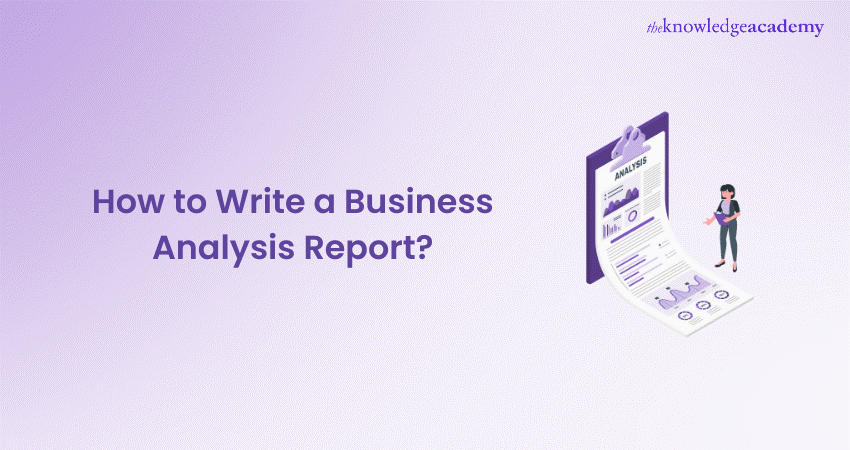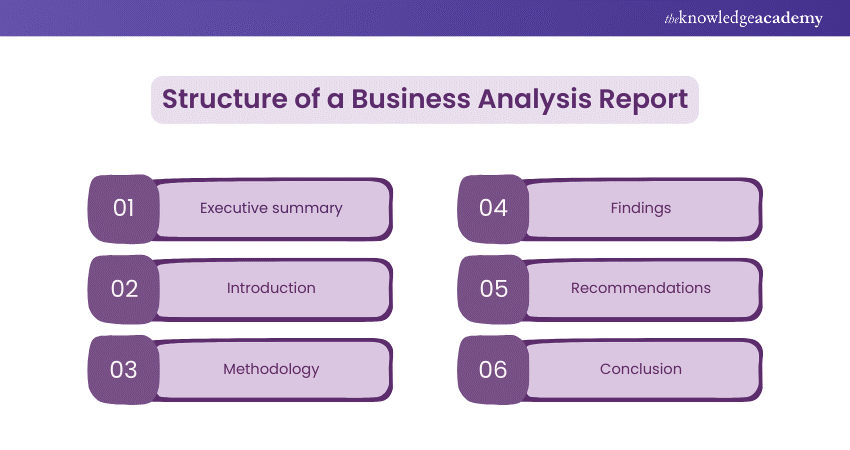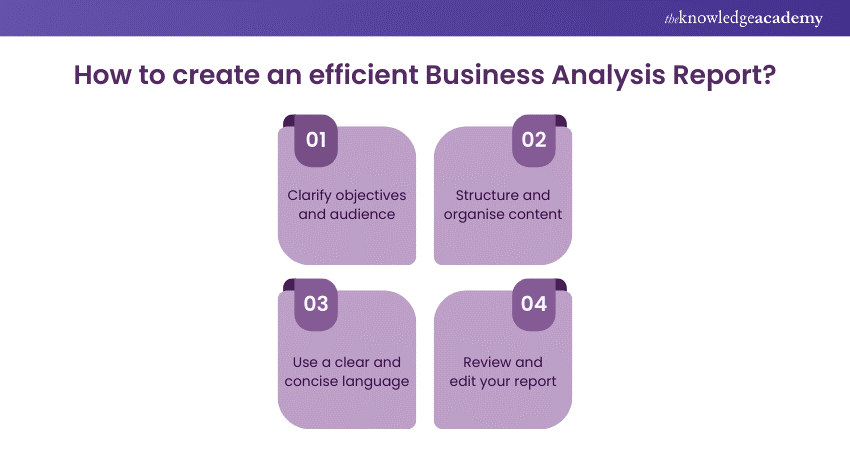We may not have the course you’re looking for. If you enquire or give us a call on 01344203999 and speak to our training experts, we may still be able to help with your training requirements.
Training Outcomes Within Your Budget!
We ensure quality, budget-alignment, and timely delivery by our expert instructors.

Rapid technological advancements and ever-changing consumer demands, nowadays, drive informed decision-making and foster sustainable growth. At its core, a Business Analysis Report strategically offers stakeholders a deep understanding of various aspects of a business. Hence, you must be aware of How to Write a Business Analysis Report to establish clear parameters inside an organisation.
Moreover, while looking for How to Write a Business Analysis Report requires a blend of analytical acumen and strategic thinking. Hence, this blog will give you a step-by-step guide to navigate this process confidently and guarantee steer tangible business outcomes.
Table of Contents
1) What is a Business Analysis Report?
2) Why is analytical reporting important?
3) Steps to write a Business Analysis Report
4) Analytical Reporting Benefits
5) Tips for creating effective Business Analysis Reports
6) Conclusion
What Is a Business Analysis Report?
An important part of the Business Analysis Report is Data Analysis, which includes business analysis techniques relating to the market and operations. It aids in policy-making, strategic planning and assessing the effectiveness of organisations’ performance.
Business reports are mostly formulated by Analysts or Consultants who are involved in data gathering and processing. Moreover, actionable recommendations must be put forward to the stakeholders by the Consultants or Analysts to come up with technical suggestions.
Why is analytical reporting important?
Managerial reporting is one of the most crucial tools through which organisations design an accurate picture of their current situation. By analysing data and presenting clear and concise insights, analytical reporting enables stakeholders to meet the following objectives:
a) Anticipate market trends and emerging opportunities.
b) Identify areas for improvement and operational efficiency.
c) Assess the effectiveness of current strategies and initiatives.
d) Make informed decisions to drive business growth.
Steps to write a Business Analysis Report
Writing an effective Business Analysis Report requires careful planning, research, and attention to detail. Discussed below is a detailed guide to help you craft a compelling report:
Preparation
Give careful thought to defining the goals and parameters of your analysis before starting the report. Determine the precise problems or issues you need to address and who the important stakeholders are. Basically, you must ensure that the pertinent data you collect is accurate and reliable by sourcing it from both internal and external sources.
Propel your career forward with the BCS Certificate in Business Analysis Practice Training – register today!
Structure
Organise your report in a logical and coherent manner to ensure clarity and readability. A typical Business Analysis Report can include the following sections:

a) Executive summary: Summarise the key findings and recommendations.
b) Introduction: Provide background information on the purpose and scope of the analysis.
c) Methodology: Explain the approach and methods used to collect and analyse data.
d) Findings: Present the results of your analysis, supported by data and evidence.
e) Recommendations: Offer actionable insights and strategies based on your findings.
f) Conclusion: Summarise the crucial points and reiterate the importance of your recommendations.
Analytical Reporting Benefits
Analytical reporting serves as a cornerstone for organisations striving for operational excellence and strategic growth. Let's delve into the key benefits it offers:
Productivity boost
This powerful tool for helps in identifying inefficiencies and bottlenecks within processes. By analysing data and performance metrics, organisations can pinpoint areas where productivity can be enhanced. Whether it is about streamlining workflows, or optimising resource allocation, analytical insights enable organisations to boost productivity and drive efficiency.
Catalyst for innovation
Analytical reporting provides valuable insights into market trends, customer preferences and emerging opportunities. By analysing data from various sources, organisations can uncover hidden patterns, identify emerging trends, and anticipate future market demands. This enables them to innovate proactively and capitalise on market opportunities, thereby fuelling creativity and driving sustainable growth.
Elevate your understanding of organisational dynamics with our BCS Foundation Certificate in Organisational Behaviour Course!
Facilitates continuous business growth
Analytical reporting helps in identifying growth opportunities and mitigating risks. By analysing market dynamics and internal performance metrics, organisations can identify areas for expansion, diversification or optimisation. Moreover, analytical insights enable organisations to anticipate potential risks and business challenges, allowing them to develop proactive strategies to mitigate them. This enables organisations to thrive in an ever-changing business environment analysis.
Enhances communication and collaboration
Analytical reporting provides stakeholders with clear and concise insights into business performance, enabling informed decision-making and fostering collaboration. Be it sharing performance metrics, or communicating key findings, analytical reporting facilitates transparency across all levels of the organisation. This promotes a culture of shared understanding and collective action, leading to improved outcomes and organisational success.
Tips for creating effective Business Analysis Reports
Crafting an effective Business Analysis Report requires careful consideration and attention to detail. Here are some essential tips to ensure your report is impactful and actionable:

1) Clarify objectives and audience
Before diving into the analysis, it is necessary to clarify the objectives of your report and identify your target audience. By clearly defining your aims, you can tailor your report accordingly. Understanding your audience’s needs will help you ensure that your report delivers relevant insights that resonate with stakeholders.
2) Structure and organise content
Organise your findings logically and coherently to guide the reader through the content. Begin with an introduction that sets the stage for the analysis. Then, present your findings systematically, grouping related information together and using visual aids to enhance understanding.
3) Use a clear and concise language
Effective communication in Business Analysis Reports necessitates using clear and succinct language. Hence, it’s important to steer clear of technical jargon or intricate terminology that can potentially bewilder or isolate your readers. Keep your writing concise and avoid unnecessary embellishment.
4) Review and edit your report
Once you have completed your analysis, take the time to review and edit your report thoroughly. Check for accuracy, consistency and clarity of language, ensuring that your findings are well-supported by evidence and data. Pay attention to formatting and layout by ensuring that the report is easy to navigate. Consider seeking feedback from colleagues or peers to ensure that your report is clear, compelling and ready for presentation.
Conclusion
In conclusion, writing a Business Analysis Report requires careful planning, analysis and enhanced communication skills. By following this detailed blog on “How to Write a Business Analysis Report”, you can create a compelling document. Along with that, it can drive informed decision-making within your organisation.
Accelerate your career with the BCS Foundation Certificate in Business Analysis Course – join us now!
Frequently Asked Questions

The five business analysis techniques commonly used are SWOT analysis, PESTLE analysis, Porter's Five Forces analysis, Fishbone diagram, and Requirements Analysis. Such techniques guarantee effective and desired outcomes.

The rule of business analysis is to thoroughly understand the organisation's needs, analyse data effectively. In addition, it includes identifying opportunities, providing actionable insights and facilitating informed decision-making for business success.

The Knowledge Academy takes global learning to new heights, offering over 30,000 online courses across 490+ locations in 220 countries. This expansive reach ensures accessibility and convenience for learners worldwide.
Alongside our diverse Online Course Catalogue, encompassing 17 major categories, we go the extra mile by providing a plethora of free educational Online Resources like News updates, Blogs, videos, webinars, and interview questions. Tailoring learning experiences further, professionals can maximise value with customisable Course Bundles of TKA.

The Knowledge Academy’s Knowledge Pass, a prepaid voucher, adds another layer of flexibility, allowing course bookings over a 12-month period. Join us on a journey where education knows no bounds.

The Knowledge Academy offers various Business Analysis Courses, including the BCS Certificate in Business Analysis Practice, BCS Foundation Certificate in Agile, and BCS Foundation Certificate in Organisational Behaviour. These courses cater to different skill levels, providing comprehensive insights into Data Architecture vs Data Modelling.
Our Business Analysis Blogs cover a range of topics related to Power BI, offering valuable resources, best practices, and industry insights. Whether you are a beginner or looking to advance your Power BI skills, The Knowledge Academy's diverse courses and informative blogs have got you covered.
Upcoming Business Analysis Resources Batches & Dates
Date
 BCS Business Analysis Diploma Oral Preparation Workshop
BCS Business Analysis Diploma Oral Preparation Workshop
Sat 29th Jun 2024
Fri 9th Aug 2024
Sat 24th Aug 2024
Sat 23rd Nov 2024
Fri 20th Dec 2024







 Top Rated Course
Top Rated Course



 If you wish to make any changes to your course, please
If you wish to make any changes to your course, please


